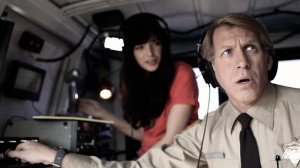Movie Review: Beware the Tire From Hell
That Rubber fails to accomplish much of interest is really a shame. Call it a waste of potential: this film is, perhaps in spite of itself, sharply current—an ideal cinematic concept of the Internet age, self-consciousness gone a muck.
Rubber. Directed by Quentin Dupieux. At Kendall Square Cinema.
By Taylor Adams
French director Quentin Dupieux’s new film, Rubber, purports to be an existential horror/comedy about an animated tire with psychic abilities that blows off the heads of its victims somewhere in the desert of the American southwest. Really, though, it’s more about the artifice, and inherent idiosyncrasies, of indie filmmaking itself.
When the rubber hits the road, this eccentric little cinematic oddity, irreverent and gloriously self-referential as it is, falls short of saying much at all—though not for lack of explicitly trying. It’s devilishly clever but guided by an arch (and self-admiring) intelligence that’s random, distracted, and at times aloof.
It’s kind of a shame, too, because the premise and certain scenes hint at a potential for the kind of cult greatness that this film probably will not attain. It’s more a late-night curiosity than an experience the likes of Rocky Horror or even The Room. It neither earns nor stumbles into greatness. Like an awkward bad joke, hanging in the air, it just kind of exists.
A character, in a pre-show audience address (the first of a few cleverly appropriated cliches), asks us to consider cinema’s many arbitrary moments or constructions. Why, for example, is the alien in E.T. brown? No reason. “This film,” says Dupieux through his mouthpiece, “is an homage to the no reason.”
This is senselessness masquerading as a big idea. For instance, we are asked why in Polanski’s The Pianist, Adrien Brody’s character has to hide “like a bum” despite his piano chops, or why the president is assassinated in Oliver Stone’s JFK. Is Dupieux joking, making a statement about the hyperreality of historic adaptation, or does he just not get it? The film isn’t coherent enough to answer that question in his favor.
For if the point of Rubber is, as implied, to allow the audience to revel and bask in the pure cinematic pleasure of meaningless spectacle and image, then it should probably be more . . . well . . . pleasurable to watch.
Apart from the threadbare plot’s expected ridiculousness, the dialog is absolutely, at times painfully, absurd (why are these south-westerners frequently using British turns of phrase and incorrect English grammar?). And though the film acknowledges these facts with a bizarre pseudo-pride (once, a character pulls out the script and reads a particularly reprehensible bit of dialog with a grimace), it’s still hard to enjoy this film, because it’s more irritating than funny.
Additionally, the cinematography is a perfect example of how close Rubber comes to following through on its potential. Multi-talented Dupieux, also a popular, French, electro musician who goes by the nom de guerre Mr. Oizo, shot it himself on a sub $3,000 digital SLR body. Considered a “prosumer” camera, it’s certainly not in the realm of Hollywood or even most indie-film resources. Despite this, many shots of the setting’s lonely, desert vistas are absolutely, triumphantly beautiful (he has “the eye,” as they say). It’s an appropriate look, where well-composed shots explore—somewhat adoringly—a cavalcade of inanimate objects that would seem to be the brethren of our protagonist: chairs, binoculars, trash, rocks, grass. They all look beautiful here.
Yet then, intermittently shaky camerawork, the occasional choppy editing, and moments of too-soft focus combine to make the film frequently visually jarring, breaking Dupieux’s visual spell.
In much the same way, the ideas behind this film are near-brilliantly clever on the surface, but there’s nothing much beneath the sheen. Spectatorship is explored via the inclusion of an actual group of movie spectators, an unflattering peanut-gallery reflection of the real audience who looks on with binoculars from the desert and whose remarks are more than likely to annoy the real viewer.
As our rubber hero watches the film’s inexplicable leading lady and attractive, “French hipster chick” archetype shower, they offer silly observations such as “This is the first time in my life I identify with a tire.” It’s as if Dupieux has discovered a new dynamic, the “object”ive gaze. It’s a clever joke for film buffs, but most other viewers won’t care—especially because it has little other purpose. Why is the tire attracted to this woman? No reason.
What is the relationship of the spectator to film? This film kills them off to see. Apparently, the actors want to go home, but they can’t until the viewers leave. As the on-screen audience is starved and then poisoned, I couldn’t help but feel we real viewers were being just as mistreated. As these on-camera viewers are starved, we’re given only scraps and fragments of good ideas to sustain our interest. The rest is pointless.
That Rubber fails to accomplish much of interest is really a shame. Call it a waste of potential: this film is, perhaps in spite of itself, sharply current—an ideal cinematic concept of the Internet age, self-consciousness gone a muck.
The absurd premise appeals to the ultra-ironic humor of the young Internet culture (I, a so-called millennial myself, had been curious, even excited, to see how it could be made into a full film). Its ideas and self-reflexivity are smart. What’s more, it was shot on equipment within the budget of most film students: Rubber has been produced and made in a way that would not have been possible in the past. But the yawning disparity between this movie’s potential and its quality sadly make it a dead end in the evolving indie film industry and culture.


